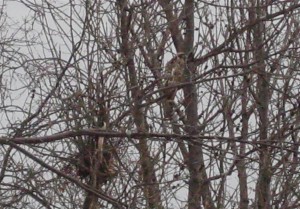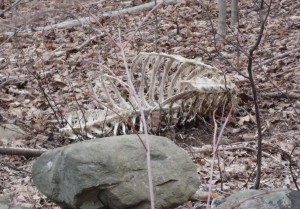Last week Chuck and I had many discussions around the subjects of good and evil, death as an advisor, impermanence, the shadow, accepting that we all have inner demons, negative energy, the capacity to commit murder, and that we must all face these things at some time in our lives or risk having to reincarnate. The subjects kept coming up again and again in various circumstances and encounters. As we sat at the breakfast table early one morning over the weekend a synchronistically powerful event occurred right before our eyes that we just could not escape. It was supremely meaningful, underscoring the very conversation we were having at the time, which centered around the capacity that we have as human beings to hide from our true nature, to want to pretend that we are only good, and how hard it is to confront the truths of our inner darkness. Life would be so much easier if everyone were happy, good, loving, kind and compassionate. I totally agree and could wish for nothing more. But as any Buddhist will tell you, it can take a lifetime of intense inner work to reach even a moment of enlightenment.
The following is a quote from The Tibetan Book of Living and Dying by Sogyal Rinpoche, which I am particularly fond of and drawn to almost daily.
“One of the chief reasons we have so much anguish and difficulty facing death is that we ignore the truth of impermanence. We so desperately want everything to continue as it is that we have to believe that things will always stay the same. But this is only make-believe. And as we so often discover, belief has little or nothing to do with reality. This make-believe, with its misinformation, ideas, and assumptions, is the rickety foundation on which we construct our lives. No matter how much the truth keeps interrupting, we prefer to go on trying, with hopeless bravado, to keep up our pretense.” -from page 25.
The author goes on to say the following:
“Reflect on this: The realization of impermanence is paradoxically the only thing we can hold onto, perhaps our only lasting possession. It is like the sky, or the earth. No matter how much everything around us may change or collapse, they endure. Say we go through a shattering emotional crisis . . . our whole life seems to be disintegrating . . . our husband or wife leaves us without warning. The earth is still there; the sky is still there. Of course, even the earth trembles now and again, just to remind us we cannot take anything for granted . . .” -from page 25 and 26.
So, what occurred before our very eyes last weekend that so profoundly affected us, as we sat at the breakfast table and chatted over our omelets and toast?
I was sitting and facing the backyard when I noticed a pair of crows doing a funny dance in the sky. They were twirling, diving and whipping about as if in the throes of a mating dance. This was my first exclamation as I pointed them out to Chuck: “Look at those dancing crows!” But there was something odd about them at the same time; they did not look really happy and I had never seen crows doing such antics. Normally they are very businesslike. They fly with purpose, heading directly to their intended destination with little fanfare or distraction. These crows were acting very strangely indeed.
We both got up from the table to watch more closely when I saw that they were not doing a mating dance to new life at all, but were in fact doing something more like a dance with death, for we saw that a huge hawk was sitting in the tree close to their nest and they were dive-bombing him, trying to scare him off. They were dealing with the true nature of reality: death comes to call; no one can escape it. They could not ignore this truth, but they could put up a valiant fight to save their young. And indeed they did. We watched as the crows repeatedly attacked the hawk, and eventually, scared it off the branch. Their fight continuing in the sky, they dove at it continually, cutting it with their wings, sending it spinning at one point and, eventually, the hawk flew off. I said to Chuck: “He’ll be back. He’s not going to give up. Just wait.”

Perhaps an hour later I happened to look outside and saw that the hawk was indeed back, his head stuck inside the nest, pecking away. The crows were nowhere in sight, but I could hear their gentle keening coming from a distance, acquiescing to the inevitable. Death had come. They were accepting the impermanence of life, that change had come and they could not do anything to thwart it, their mournful cries marking this truth.
Chuck and I watched the hawk tearing at something under its claw, though even with binoculars it was difficult to see what it was; an egg or a baby crow we could not tell, but the truth was plain to see. Eventually the hawk flew off the branch and, as it did, the crows flew up out of hiding and, with one last cry of pain, attacked it again before it flew off for good. I expected the crows to return to the tree where their nest lay disturbed, but was surprised to see that they did not. “Wow,” I thought, “they really do accept the loss, they aren’t even looking back, just moving on.”
I don’t know what transpired after that, if they did in fact go back to see if anything had survived, but I think they already knew that nothing remained, that the hawk was just doing what he should do, what they in turn do to smaller birds; that it was just nature. But the sky was still there, as Sogyal Rinpoche writes, and they took off into it. The earth was still there too.

“What is our life but this dance of transient forms? Isn’t everything always changing: the leaves on the trees in the park, the light in your room as you read this, the seasons, the weather, the time of day, the people passing you in the street? And what about us? Doesn’t everything we have done in the past seem like a dream now?… We are impermanent, the influences are impermanent, and there is nothing solid or lasting anywhere that we can point to.” –The Tibetan Book of Living and Dying pages 26 and 27.
The only thing we can really count on is now, this moment, this breath we take, this truth that at this moment in our life we are alive. And then the next moment is upon us, even as we let the last one go. Each moment is as impermanent as the last.
Personally, I am awestruck by such acts of nature. They are always thrilling moments. I feel lucky to live where I do, that I can have such moments of brilliance in my life, that I am offered such grittiness to reflect on. I cannot say that I would be able to fly off as easily as those crows did, though eventually I get there. I know myself well enough now; that after many years of inner work I am fully capable of walking on into life without regret or sorrow. I know how to face new life, letting go of the past, though I have learned to appreciate that death, in its many forms, always accompanies me.
I don’t mean to be morbid, especially with so many experiences of life abounding now, each new spring day bringing nesting birds, emerging plants and flowers, the earth reawakening. But I cannot help but point out the truth that we are all impermanent, that we must all one day dance with death. We already do it all the time, in so many small ways.
We must learn to face our own deaths each day, preparing for it in our thoughts and actions, learning from the crows how to let go. We must also learn from the hawk that we too are capable of taking what we need to live; we too kill to survive. We must keep learning from the people in our lives how to face the transient nature of life, learning from them what the most important questions to keep asking are. We must all face the truths of our make-believe worlds and face the grittiest of the truths of reality. I am thankful for everyone who is a part of my life, even if only peripherally, for showing me that everything is meaningful and how important it is to keep working on the personal inner process.
As the seers of ancient Mexico are so fond of saying: I am a being who is going to die. The hawk and the dancing crows teach us this. Chuck and I learned this again last weekend as we watched this lesson play out in the sky. But, in the meantime, we intend to fully live, for we have so much to still learn.
Living fully, sending you all love and good wishes,
Jan
If you wish to correspond, please feel free to post a comment below. And don’t forget to check out our facebook page at: Riverwalker Press on facebook where we post comments, photos, and quotes.
